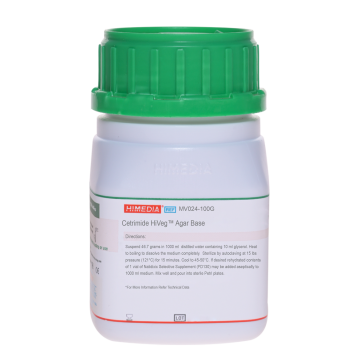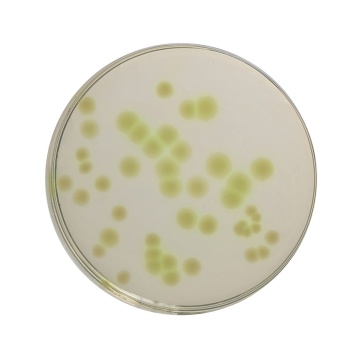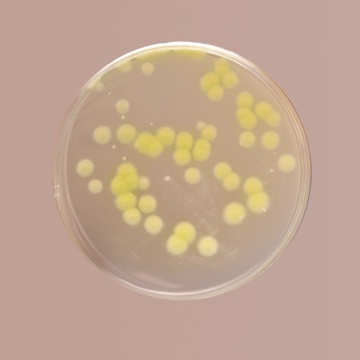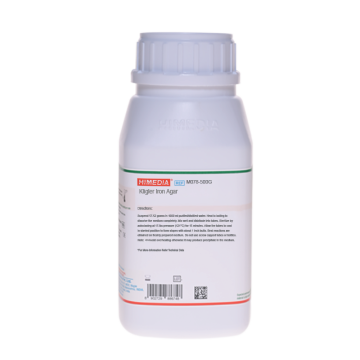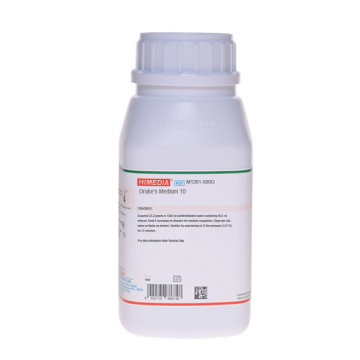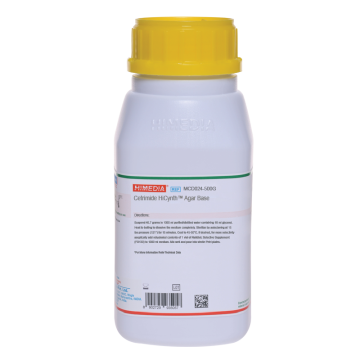 Your enquiry has been submitted
Your enquiry has been submitted
Cetrimide Agar Base
Intended use
Recommended for the selective isolation of Pseudomonas aeruginosa from water and clinical specimens.
Composition**
| Ingredients | g/L |
|---|---|
| Gelatin peptone | 20.000 |
| Magnesium chloride | 1.400 |
| Potassium sulphate | 10.000 |
| Cetrimide | 0.300 |
| Agar | 15.000 |
Final pH (at 25°C): 7.2±0.2
**Formula adjusted, standardized to suit performance parameters
Directions
Suspend 46.7 grams in 1000 ml purified/distilled water containing 10 ml glycerol. Heat, to boiling, to dissolve the medium completely. Sterilize by autoclaving at 15 lbs pressure (121°C) for 15 minutes. Cool to 45-50°C. If desired, rehydrated contents of 1 vial of Nalidixic Selective Supplement (FD130) may be added aseptically to 1000 ml medium. Mix well and pour into sterile Petri plates.
Principle And Interpretation
Pseudomonas aeruginosa grows well on all normal laboratory media but specific isolation of the organism, from environmental sites or from human, animal or plant sources, is best carried out on a medium, which contains a selective agent and also constituents to enhance pigment production. Most selective media depend upon the intrinsic resistance of the species to various antibacterial agents. Cetrimide inhibits the growth of many microorganisms whilst allowing Pseudomonas aeruginosa to develop typical colonies.
Cetrimide is a quaternary ammonium salt, which acts as a cationic detergent that reduces surface tension in the point of contact and has precipitant, complexing and denaturing effects on bacterial membrane proteins. It exhibits inhibitory actions on a wide variety of microorganisms including Pseudomonas species other than Pseudomonas aeruginosa. King et al developed Medium A for the enhancement of pyocyanin production by Pseudomonas (1). Cetrimide Agar developed by Lowburry (1) is a modification of Tech Agar (Medium A) with addition of 0.1% cetrimide for selective isolation of P.aeruginosa. Later, due to the availability of the highly purified cetrimide, its concentration in the medium was decreased (2,3). The incubation was carried out at 37°C for a period of 18-24 hours (4).
P.aeruginosa can be identified due to their characteristic production of pyocyanin, a blue, water-soluble, non-fluorescent phenazine pigment coupled with their colonial morphology and the characteristic grape-like odor of aminoacetophenone (5). P.aeruginosa is the only species of Pseudomonas or gram-negative rod known to excrele pyocyanin. These media are therefore, important in the identification of P.aeruginosa. These media are used for the examination of cosmetics (6) and clinical specimens (5,7) for the presence of P.aeruginosa, as well as for evaluating the efficacy of disinfectants against this organism (8).
Gelatin peptone provide necessary nutrients for P.aeruginosa. Sodium chloride maintains osmotic equilibrium in the medium. Magnesium chloride and potassium sulfate stimulates pyocyanin production (9).
For the isolation of P.aeruginosa, plates of Cetrimide Agar should be inoculated from non-selective medium such as Brain Heart Infusion Broth (M210) or Soyabean Casein Digest Medium (M011). If the count is high, the test sample can be directly inoculated onto Cetrimide Agar. P.aeruginosa colonies may appear pigmented blue, blue-green or non-pigmented. Colonies exhibiting fluorescence at 250nm and a blue green pigmentation are considered as presumptive positive. P.aeruginosa may lose its fluorescence under UV if the cultures are left at room temperature for a short time. Fluorescence reappears after the plates are re-incubated (4). Type of peptone used in the base may also affect pigment production (4,10).
Certain strains of P.aeruginosa may not produce pyocyanin. Other species of Pseudomonas do not produce pyocyanin but fluoresce under UV light. Most non-Pseudomonas species are inhibited on Cetrimide Agar, and some species of Pseudomonas may also be inhibited. Some non-fermenters and some aerobic spore formers may exhibit a water-soluble tan to brown pigmentation on this medium. Serratia may exhibit pink pigmentation (3). Biochemical tests and serological procedures should be performed to confirm the findings.
Type of specimen
Clinical samples - urine, wound ; Water samples
Specimen Collection and Handling:
For clinical samples follow appropriate techniques for handling specimens as per established guidelines (11,12).
For water samples, follow appropriate techniques for sample collection, processing as per guidelines and local standards(13).
After use, contaminated materials must be sterilized by autoclaving before discarding.
Warning and Precautions :
In Vitro diagnostic Use. For professional use only. Read the label before opening the container. Wear protective gloves/ protective clothing/eye protection/ face protection. Follow good microbiological lab practices while handling specimens and culture. Standard precautions as per established guidelines should be followed while handling clinical specimens. Safety guidelines may be referred in individual safety data sheets.
Limitations :
- This medium is a selective medium, some strains may show poor growth as cetrimide is highly toxic.
- Further biochemical tests must be carried out for further confirmation.
Performance and Evaluation
Performance of the medium is expected when used as per the direction on the label within the expiry period when stored at recommended temperature.
Quality Control
Appearance Cream to yellow homogeneous free flowing powder
Gelling Firm, comparable with 1.5% Agar gel
Colour and Clarity of prepared medium Light amber coloured opalescent gel with a slight precipitate forms in Petri plates
Reaction Reaction of 4.67% w/v aqueous solution containing 1% glycerol at 25°C. pH: 7.2±0.2
pH 7.00-7.40
Cultural response Cultural response was observed after an incubation at 30-35°C for specified time. Recovery rate is considered as 100% for bacteria growth on Soyabean Casein Digest Agar.
| Organism | Inoculum (CFU) | Growth | Observed Lot value (CFU) | Recovery | Incubation temperature | Incubation period |
|---|---|---|---|---|---|---|
| ^Pseudomonas paraeruginosa ATCC 9027 (00026*) | 50-100 | luxuriant | 25-100 | >=50% | 30-35 °C | <=18 hrs |
| Escherichia coli ATCC 8739 (00012*) | >=104 | inhibited | 0 | 0% | 30-35 °C | >=72 hrs |
| Pseudomonas aeruginosa ATCC 27853 (00025*) | 50-100 | luxuriant | 25-100 | >=50% | 30-35 °C | 18-24 hrs |
| Pseudomonas aeruginosa ATCC 25668 (00114*) | 50-100 | luxuriant | 25-100 | >=50% | 30-35 °C | 18-24 hrs |
| Stenotrophomonas maltophila ATCC 13637 | >=104 | inhibited | 0 | 0% | 30-35 °C | >=72 hrs |
| Escherichia coli ATCC 25922 (00013*) | >=104 | inhibited | 0 | 0% | 30-35 °C | >=72 hrs |
| Staphylococcus aureus subsp.aureus ATCC 6538 (00032*) | >=104 | inhibited | 0 | 0% | 30-35 °C | >=72 hrs |
| Staphylococcus aureus subsp.aureus ATCC 25923 (00034*) | >=104 | inhibited | 0 | 0% | 30-35 °C | >=72 hrs |
| Salmonella Typhimurium ATCC 14028 (00031*) | >=104 | inhibited | 0 | 0% | 30-35 °C | >=72 hrs |
| Proteus mirabilis ATCC 29906 (00023*) | >=104 | inhibited | 0 | 0% | 30-35 °C | >=72 hrs |
Key: *Corresponding WDCM numbers, ^ Formerly known as Pseudomonas aeruginosa
Storage and Shelf Life
Store between 10-30°C in a tightly closed container and the prepared medium at 20-30°C. Use before expiry date on the label. On opening, product should be properly stored dry, after tightly capping the bottle in order to prevent lump formation due to the hygroscopic nature of the product. Improper storage of the product may lead to lump formation. Store in dry ventilated area protected from extremes of temperature and sources of ignition Seal the container tightly after use. Product performance is best if used within stated expiry period.
Disposal
User must ensure safe disposal by autoclaving and/or incineration of used or unusable preparations of this product. Follow established laboratory procedures in disposing of infectious materials and material that comes into contact with clinical sample must be decontaminated and disposed of in accordance with current laboratory techniques (11,12).
Reference
- King, Ward and Raney, 1954, J. Lab. Clin. Med., 44:301.
- Lowbury, 1951, J. Clin. Pathol., 4:66.
- Lowbury and Collins, 1955, J. Clin. Pathol., 8:47
- Brown and Lowbury, 1965, J. Clin. Pathol., 18:752.
- Murray P. R., Baron J. H., Pfaller M. A., Jorgensen J. H. and YolkenR. H., (Ed.), 2003, Manual of Clinical Microbiology, 8th Ed., American Society for Microbiology, Washington, D.C.
- USFDA Bacteriological Analytical Manual, 2005, 18th Ed., AOAC, Washington, DC.
- Forbes B. A., Sahm A. S. and Weissfeld D. F., Bailey & Scotts Diagnostic Microbiology, 10th Ed., 1998, Mosby, Inc., St. Louis, Mo.
- Williams, (Ed.), 2005, Official Methods of Analysis of the Association of Official Analytical Chemists, 19th Ed., AOAC, Washington, D.C
- MacFaddin J. F., 1985, Media for Isolation-Cultivation-Identification -Maintenance of Medical Bacteria, Vol. I, Williams and Wilkins, Baltimore.
- Goto and Enomoto, 1970, Jpn. J. Microbiol., 14:65.
- Isenberg, H.D. Clinical Microbiology Procedures Handbook. 2nd Edition.
- Jorgensen, J.H., Pfaller, M.A., Carroll, K.C., Funke, G., Landry, M.L., Richter, S.S and Warnock., D.W. (2015) Manual of Clinical Microbiology, 11th Edition. Vol. 1.
- Lipps WC, Braun-Howland EB, Baxter TE, eds. Standard methods for the Examination of Water and Wastewater, 24th ed. Washington DC:APHA Press; 2023.
| Product Name | Cetrimide Agar Base |
|---|---|
| SKU | M024 |
| Product Type | Regular |
| Physical Form | Powder |
| Origin | Animal |
| Packaging type | HDPE |
| References | 1.King, Ward and Raney, 1954, J. Lab. Clin. Med., 44:301. 2.Lowbury, 1951, J. Clin. Pathol., 4:66. 3.Lowbury and Collins, 1955, J. Clin. Pathol., 8:474.Brown and Lowbury, 1965, J. Clin. Pathol., 18:752. 5.Murray P. R., Baron J. H., Pfaller M. A., Jorgensen J. H. and YolkenR. H., (Ed.), 2003, Manual of Clinical Microbiology,8th Ed., American Society for Microbiology, Washington, D.C. 6.USFDA Bacteriological Analytical Manual, 2005, 18th Ed., AOAC, Washington, DC. 7.Forbes B. A., Sahm A. S. and Weissfeld D. F., Bailey & Scotts Diagnostic Microbiology, 10th Ed., 1998, Mosby, Inc., St.Louis, Mo. 8.Williams, (Ed.), 2005, Official Methods of Analysis of the Association of Official Analytical Chemists, 19th Ed., AOAC,Washington, D.C.9.MacFaddin J. F., 1985, Media for Isolation-Cultivation-Identification -Maintenance of Medical Bacteria, Vol. I, Williamsand Wilkins, Baltimore. 10.Goto and Enomoto, 1970, Jpn. J. Microbiol., 14:65. 11.Greenberg A. E., Clesceri L. S. and Eaton A. D., (Eds.), 2005, Standard Methods for the Examination of Water andWastewater, 21st ed., APHA, Washington, D.C. 12.Isenberg, H.D. Clinical Microbiology Procedures Handb0ook. 2nd Edition. 13.Jorgensen,J.H., Pfaller , M.A., Carroll, K.C., Funke, G., Landry, M.L., Richter, S.S and Warnock., D.W. (2015)Manual of Clinical Microbiology, 11th Edition. Vol. 1. |
| Customized Product Available | No |




